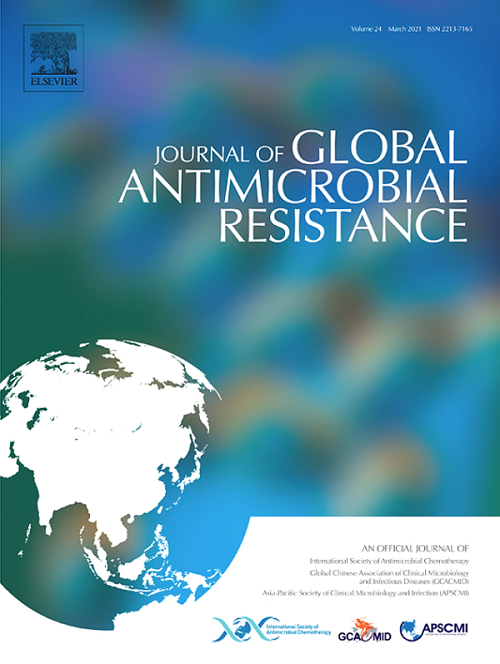Occurrence of mcr-1.1-producing Escherichia coli in clinical settings in Tunisia
IF 3.2
3区 医学
Q2 INFECTIOUS DISEASES
引用次数: 0
Abstract
Objective
Our study aims at characterizing a mcr-1-producing Escherichia coli ST224 clinical isolate collected at the University Hospital of Sahloul-Sousse from a joint infection.
Methods
Phenotypic characterization was performed using a Vitek-2 System. NGS was performed by short-read (150 bp paired-end reads) sequencing on a NovaSeq6000 platform, as well as by long-read sequencing using an ONT R10.4 flow cell. Hybrid assembly was achieved using the Flye de novo assembler, and analyses were performed using tools of the Center for Genomic Epidemiology. The mcr-1-carrying plasmid was compared by BLAST to similar plasmids recovered in the NCBI database and visualized by PROKSEE.
Results
The collected E. coli belonged to ST224 and was multi-drug resistant, remaining susceptible to carbapenems, amikacin, gentamicin, and sulfamethoxazole only. Resistances to last-generation cephalosporins (mediated by blaCMY-2) and fluoroquinolones were chromosomally-encoded. The mcr-1.1 gene was carried by an Inc12 plasmid similar but not identical to published data, and that lacked the two copies of the ISApl1 element usually bracketing the mcr-1.1 and pap2 genes.
Conclusions
The dissemination of plasmid-encoded mcr-1 genes that can spread across species and sectors is a major health issue in countries such as Tunisia, where colistin is essential for the treatment of complicated human infections due to carbapenem-resistant Enterobacterales. Reporting all mcr-1-positive E. coli clinical isolates is thus important to understand the dynamic of spread of these resistant pathogens.
突尼斯临床环境中产生mcr-1.1的大肠杆菌的发生
目的:。我们的研究旨在鉴定从萨赫勒-苏塞大学医院收集的一株产mcr-1的大肠杆菌ST224临床分离株。方法:。使用Vitek-2系统进行表型表征。NGS通过NovaSeq6000平台上的短读(150 bp对端reads)测序和ONT R10.4流式细胞上的长读测序进行。使用Flye de novo组装器实现杂交组装,并使用基因组流行病学中心的工具进行分析。用BLAST将携带mcr-1的质粒与NCBI数据库中回收的类似质粒进行比较,并用PROKSEE进行可视化。结果:。收集到的大肠杆菌属ST224,多重耐药,仅对碳青霉烯类、阿米卡星、庆大霉素和磺胺甲恶唑敏感。对上一代头孢菌素(blaCMY-2)和氟喹诺酮类药物的耐药性是染色体编码的。mcr-1.1基因由Inc12质粒携带,该质粒与已发表的数据相似,但不完全相同,并且缺少通常包围mcr-1.1和pap2基因的ISApl1元素的两个拷贝。结论:。质粒编码的mcr-1基因的传播可以跨物种和部门传播,这是突尼斯等国家的一个主要卫生问题,在这些国家,粘菌素对于治疗由碳青霉烯耐药肠杆菌引起的复杂人类感染至关重要。因此,报告所有mcr-1阳性大肠杆菌临床分离株对于了解这些耐药病原体的传播动态非常重要。
本文章由计算机程序翻译,如有差异,请以英文原文为准。
求助全文
约1分钟内获得全文
求助全文
来源期刊

Journal of global antimicrobial resistance
INFECTIOUS DISEASES-PHARMACOLOGY & PHARMACY
CiteScore
8.70
自引率
2.20%
发文量
285
审稿时长
34 weeks
期刊介绍:
The Journal of Global Antimicrobial Resistance (JGAR) is a quarterly online journal run by an international Editorial Board that focuses on the global spread of antibiotic-resistant microbes.
JGAR is a dedicated journal for all professionals working in research, health care, the environment and animal infection control, aiming to track the resistance threat worldwide and provides a single voice devoted to antimicrobial resistance (AMR).
Featuring peer-reviewed and up to date research articles, reviews, short notes and hot topics JGAR covers the key topics related to antibacterial, antiviral, antifungal and antiparasitic resistance.
 求助内容:
求助内容: 应助结果提醒方式:
应助结果提醒方式:


